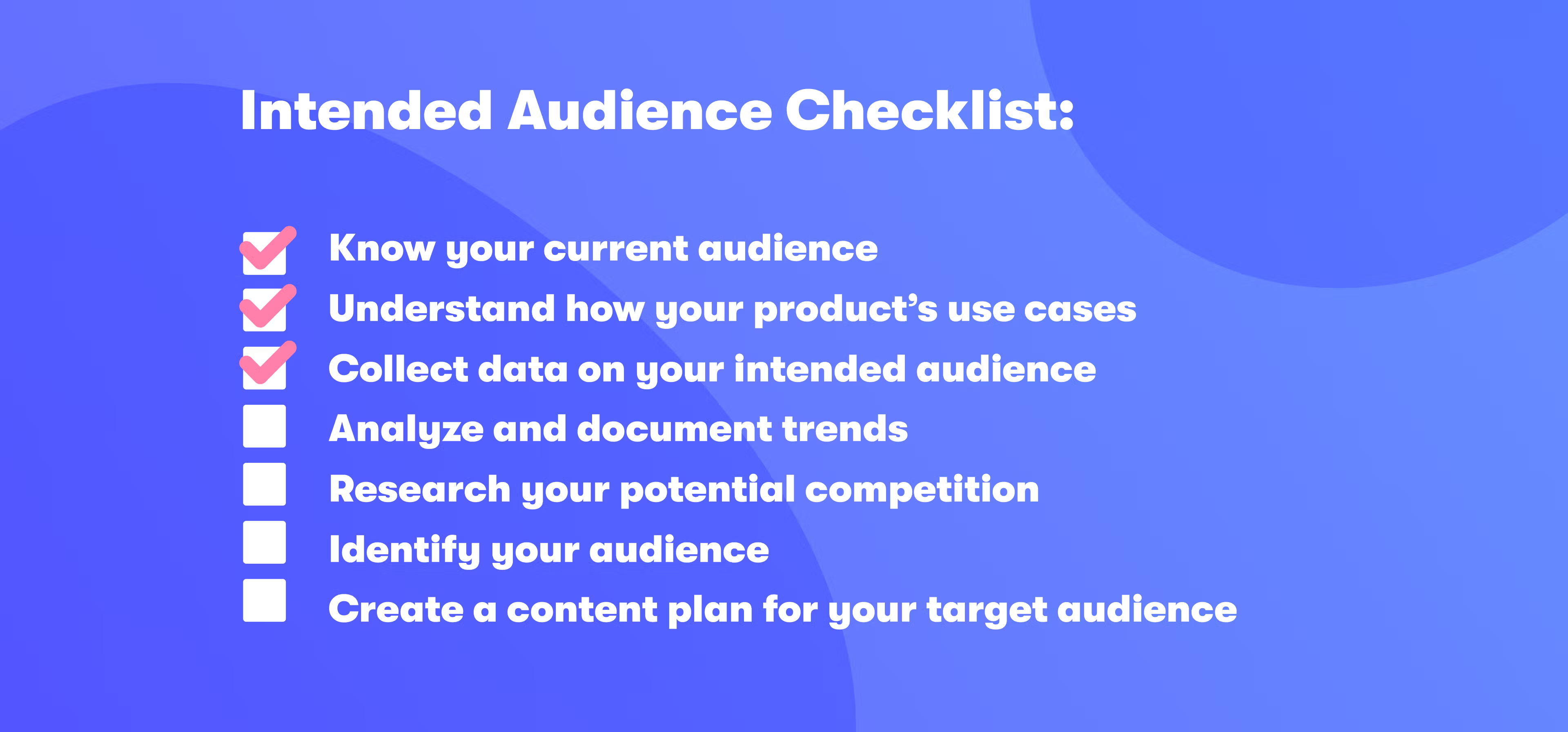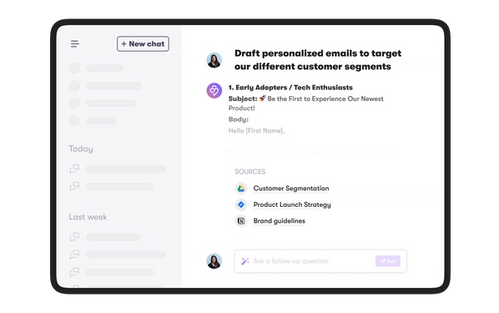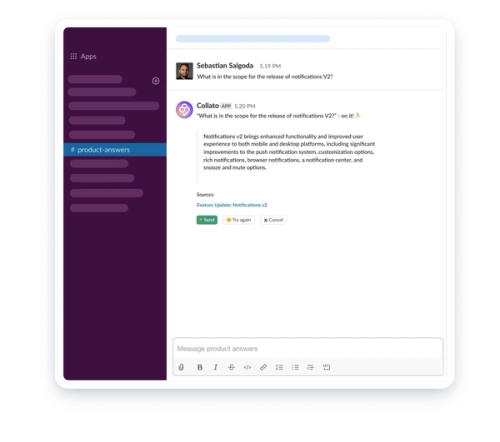How to Determine Your Intended Audience

What is an intended audience?
If you share your Netflix account with someone, then you're probably familiar with the classic "Who's watching?" screen. You know, it's the one with all the different icons and usernames. Well, that's a small way Netflix finds its intended audience; they tailor recommended shows based on what the user liked in the past or often watches. Because let's face it, you probably have a different taste in entertainment than your parents, siblings, etc.
Finding your intended audience for your brand works similarly and is the foundation of your marketing content strategy. An intended audience is the people most likely to be interested in your product and services. They fit into the specific demographics drawn out in your marketing strategy or exhibit behaviors that make them a perfect match for your product. It requires a deep understanding of who your ideal customers are and which competitors you should look out for, as well as knowledge of your product.
Target audience vs. target market - what's the difference?
They sound pretty similar, but the slight differences between the target audience and target market are worth knowing. The target market is the whole group of people to which a brand wants to sell. The target audience is much more limited. It's the group of individuals you expect to buy your product.
A little mind-boggling? Think of it like this: Say a company offers German lessons. Their target market would be everyone who can afford the courses and desires to learn the language, while the target audience would be the people looking for a specific class. Their target audience might use search queries like 'conversational German' or 'workplace German.'
What to know BEFORE you do audience research
You need to know a few things before you conduct audience research. It means learning your product or service inside-out and understanding your competition.
🤓 Become a product expert - It might seem obvious, but your entire marketing team must know your product or service. How can you create any content around a product you don't understand? Read your website, brochures, pamphlets, catalogs, and advertisements. Talk with team members outside your department to see how they view the product. If possible, use the product yourself and test its capabilities and limitations.
❤️🩹 Access pain points - A large part of learning your product is pinpointing the problems that it solves. If you can answer this question, it'll give you valuable insight into your intended audience later down the road. For example, if you’re selling a thermos that keeps liquids warm, then you're saving busy commuters time in the morning by allowing them to drink their coffee on the go.
🤼 Identify your competitors - Do you know the market? Well, you certainly should. Find out who your competitors are and analyze their intended audience. It might uncover customers' pain points that haven't been addressed yet or guide your audience research and content strategy.
Examples of intended audience
A lot goes into identifying the right audience - age, income, and gender are just the beginning. To make this beastly task more approachable, there are three overarching categories for finding your intended audience: purchase intentions, interests, and demography. Let’s explore them all in a little more detail:
🛍️ Purchase intentions - If you're in the realm of e-commerce, purchase intention data is crucial. It usually works by dividing people who recently looked for a specific product into groups. The product could be anything: app subscriptions, smartphones, kitchen appliances; but what's important is that these customers haven't looked for it previously. Essentially it means that they want to buy a new thing, but first want more information about the demanded product. That's where you come in.
You want to find out who these people are and exactly what they're looking to buy. That way, you direct more people to your services. It expands your audience!
🤔 Interests - Gathering information on users' interests gives you powerful knowledge about your customers, allowing you to engage with them in a way that makes your product attractive to them. For example, if you're selling backpacking equipment, you would probably market to people who love the outdoors.
Interests can include anything from hobbies, passions, things that customers are reading about, or even listening to.
🌐 Demographics - This data is all about the socioeconomic factors that make up a customer. In other words, it's the attributes and characteristics of your customers, including age, income, education, gender, geographic location, religion, occupation, and so on. Like our last point, demographics are valuable because you can market your service to the correct people. For instance, you probably wouldn't advertise skateboards to grandmas, but rather to teenagers and younger people.
🕵️♀️ Helpful hint: be cautious when stereotyping an audience based on demographics. People are more rounded and complex than a basic category. Instead, consider which factors will be most important for your product.
When creating your marketing plan, you can use just one type of audience characteristic or incorporate multiple elements to understand precisely who you're reaching. While these categories are popular among marketers, there are many more ways to find your intended audience.

10 creative ways to identify your intended audience
So now that you fully comprehend your product and its potential, as well as your most fierce competitors, it's time to determine your target audience. We've compiled some ideas that'll support you through the process.
- Create a reader persona - A reader persona, also known as a buyer persona, is a fictional character who represents your intended audience. They ideally incorporate the target demographics for your product. A reader persona can help find your intended audience because it helps marketing teams envision what the customer needs. It can help narrow down what type of person you’re targeting.
- Look at your social media analytics - A large part of finding your intended audience is understanding your current audience. Social media can help with that by determining demographics, like age, gender, and location. By using audience segmentation, social media can give you hints on who your users are at the moment, which helps you nail down your intended audience.
- Engage with your social media followers - Social media engagement measures how people are interacting with your social media content, maybe through likes and favorites, comments, DMs, shares and saves, clicks, and mentions. To find your current audience and increase your engagement with potential audiences, make sure you’re being social! That means responding to people when they ask questions, tracking who sees and saves your posts, commenting on other people’s posts, finding similar brands and checking out their followers, etc. Once you have a good idea of who’s interacting with your platforms, then you can analyze who your intended audience should be.
- Use Facebook Audience Insights - Facebook Audience Insights a tool used by marketers for ad campaigns. As the name suggests, this tool helps you to understand your audience based on collected Facebook data. Note that Facebook Audience Insights is NOT the same as Facebook Insights!
- Check website behavior - See who visits your website and what exactly they do there. Are they looking at your blog content? Logging into your service? Looking through your product offerings? Tracking the patterns on your website can provide valuable insights on how people use your services and may hint at the content that’s most useful to your user. Then you can tailor your audience research based on these content types.
- Document everything - It’s really smart to create a space dedicated to keeping track of your audience, whether it’s existing or intended. You can see trends and better understand who is interested in the product or service you provide.
- Think benefits, not features - This plays into finding the pain points of your intended audience. It’s best to concentrate on the benefits of your product or service, the things that make your customer’s life better. If you access the problems that a certain group is experiencing, and then offer a solution, you have your intended audience right off the bat.
- Build a community - When just starting out, a unique way to find your intended audience could be through a community-based platform. Maybe your service is built around a marketing team, which means you can build a community around marketing workflows and productivity. There are many platforms that help with this: Medium (long form articles), social media of course, Slack channels, etc.
- Create a webinar - A webinar is another way to maintain a positive relationship with your intended audience. Share your knowledge and expertise with your audience in exchange for some telling user details. If your webinar is live, then talk to participants directly, ask them about their positions, roles, and responsibilities and connect these experiences to your webinar topic. If your webinar is asynchronous, provide a space for participant information and feedback. Document this information for a later date so you can analyze your intended audience.
- Give away free content that's worth paying for - If you’re too camera shy to record a webinar, create downloadable content and resources that people can access for free. They just have to answer a few questions (job title, roles, responsibilities, etc.) or provide an email to receive access. Keep track of who downloaded your content to find out who your audience is or could be.
The best tools for finding your target audience
It might take multiple tools to get your ideal audience, but using a combination of these tools will provide the most clear-cut data available.
Google Analytics - Google Analytics is an invaluable tool when it comes to audience research. The Audiences report gives you insight into your users demographics, interests, behavior, and more. It allows you to group types of users together based on properties and characteristics that you determine are important. This report can be as broad or as specific as you need them to be.
SEO and keyword research tools - SEO tools deliver precise empirical data. You can use them to determine exactly which keywords your demographic is using to find you–or vice versa. Focus on the keywords that support your brand and see how those keywords are working. The people who google your keywords or anything relatively related will be your target audience. After that, you can select a few users and use them to create a customer persona. At Collato, we use Google Keyword Planner, Google Search Console, AnswerThePublic, Keywords Everywhere, and Ahrefs to help us out with keywords.
Track audience behavior - Your website likely receives traffic. Some tools like Hotjar track the actions of users, which can provide valuable details about your current audience. For instance, where your visitors click on your website, how far down they scroll on each page, which links get a high percentage of clicks, and so on. When you recognize patterns in how existing visitors behave, you can target other people who haven't yet found you. Or you can adjust content to align more with your target market.
That's a wrap!
Finding your intended audience is hard work, no doubt about it! There are numbers, data analysis, brainstorming, and problem-solving involved. But when you take the time and effort to identify your intended audience, it will help you master your brand messaging and marketing strategies.





